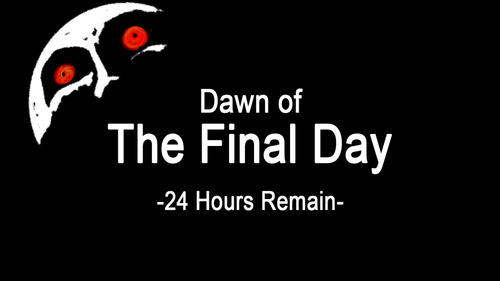How Majora’s Mask Succeeded by Crafting a Small But Intricate World
Posted on April 19 2020 by Sean Gadus

The Legend of Zelda: The Ocarina of Time was, and still is, one of the most acclaimed video games of all time. Released in 1998, Ocarina of Time broke numerous sales records and introduced numerous innovations to 3D action/adventure games. Across all commonly accepted metrics, the game was a colossal success. And only two years after Ocarina of Time‘s release, Nintendo released Majora’s Mask, a sequel that had a large number of mechanical and graphical similarities to its 1998 predecessor.
Despite the heavy expectations places on it, Majora’s Mask remains one of the most revered sequels from the past twenty years. Despite reusing many character models and assets from Ocarina of Time, the sequel succeeded by crafting a small but intricate world. By creating such an immersive and complex world, Majora’s Mask become an unforgettable experience that is still revered twenty years after its release.
Ground Hog’s Day — The Innovative Time System That Makes The World Work

Gaming experts often trace the origins of Majora’s Mask to one of several Zelda projects in production for the Nintendo 64. Because of this, the game that would become Majora’s Mask reused many of the same assets and models that were created for Ocarina of Time. This means that Majora’s Mask has many visual similarities to its predecessor, which could have made it harder to distinguish it from said predecessor. Fortunately, the development team behind Majora’s Mask implemented a brilliant time system that would ensure that the game was suitably different from Ocarina of Time.
In contrast to Ocarina, which mainly operates on a very simple Day/Night cycle, Majora’s Mask‘s three-day cycle allowed for hour-by-hour changes that felt much more advanced compared to its predecessor. While the areas of Majora’s Mask may not feel as vast or as grand as areas within Ocarina of Time, the new time system allows much more intricate events to take place across the limited seventy-two hour period. While Ocarina of Time is often focused on exploring new places, Majora’s Mask is more focused around replaying the three-day cycle over and over again, learning the movements of characters, and knowing when to trigger key events. A playthrough of Majora’s Mask is actually dozens of replays of the same three-day cycle, with the player learning more and more about different parts of the world each time. Whether the player is completing simple side-quests, hunting for extras, or completing parts of the main dungeons, the game is all about taking what you have learned about the world and applying it to your next three-day cycle.
The time system was, and still is, extremely distinct within video games. While open world games use nuanced time systems, many of these games are focused on large, open spaces, rather than small areas. The key aspect of Majora’s Mask is that the world is small enough that a player can learn almost everything about Termina and its citizens. One game that followed the Majora’s Mask template was The Sexy Brutale, in which the player is tasked with exploring a mansion as its inhabitants are being murdered. Like Majora’s Mask, the game is about learning how to work within a limited time restraint and how to effectively move through a strange and macabre world. The brilliance of both games is that their development teams made brilliant use of limited time and space, forging unforgettable experiences around these limitations. And if these games are any indications, a devotion to crafting small yet rich worlds should be taken advantage of more often in the gaming landscape.
Majora’s Mask Created More Intimate and Intricate Quests

Majora’s Mask sets itself apart from its iconic predecessor with intimate character-driven side-quests. Within the scope of three days, the developers created an assortment of joyful, humorous, and tragic moments for its wide cast of side characters. While the main quest of Majora’s Mask requires one to engage with some key characters, some of the game’s best character moments were woven into optional side-quests. The game also included the Bomber’s Notebook, an inventory system that allows the player to keep track of the many different side quests. The Bomber’s Notebook was even vastly improved for the Majora’s Mask 3D rerelease.
One great way to show how much Majora’s Mask had advanced compared to Ocarina of Time is to look at the Biggoron Sword Quest in Ocarina of Time and the Kafei and Anju Quest in Majora’s Mask. Both of these quests are the most elaborate and complex side-quests within their respective games. The quest for the Biggoron Sword is extremely passive, allowing the player to take steps toward completion at their leisure (aside from a few timed segments), with very little meaningful engagement with non-playable characters. In contrast, the more sophisticated Kafei and Anju quest requires the player to trigger time specific events. If you miss certain moments, then you lose the thread of the quest. While the quest ultimately rewards you with a unique mask, the true reward is to see what happens to the two characters at the end of question. Many of the quests in Majora’s Mask have an emotional payout that were made possible by a more intricate time system.
Another great side quest is the Romani Ranch quest. This two-part quest cannot be completed until after Link has gained the Goron Mask and Powder Keg item. While the early part of the quest is required to complete the main game (the player needs Epona to get to the Great Bay area), the majority of the quest is not required to complete the main Majora’s Mask storyline. The first optional part of the quest involves helping Romani and Cremia ward off aliens who want to steal their cows, an absurd moment that demonstrates the trademark weirdness of Majora’s Mask. The remaining part of the quest involves protecting Romani and her wagon from the Gorman brothers. Both parts of the quest require you to be at Romani Ranch at the right times in order to go through the scripted events. If you arrive on the second or third day, you will miss all these key moments and the emotional payoffs for helping the two sisters are gone.
Overall, many of the quests within Majora’s Mask focus on unique characters and their plights, side quests that take advantage of the intricate time system within the game. Because of the time system, the player has to be at the right place at the right time to complete the side-quest, but luckily the player always has another chance to get them right. Whether it is the love story of Anju and Kafei, the problems at Romani Ranch, or any of the other smaller side-quests, Majora’s Mask created many optional stories that focus on a wide gallery of intriguing non-playable characters.
Conclusion

Majora’s Mask is an extremely special game within the Legend of Zelda series. The intricate time system, with the entire game taking place over an inescapable seventy-two hour time period, serves as the game’s most important mechanic. The development team used this mechanic to create a small but intricate world, one packed with side-quests and optional activities. Rather than feeling like a detriment, the time system forces the player to learn more and more about the well-crafted world through each three-day cycle. By end of the experience, many players will know the world and characters of Majora’s Mask more intimately than the places and characters in almost any other Zelda game.
Because of this, Majora’s Mask is one of the only games where the side quests feel essential to the overall story. Each carefully built side quest adds a nuance to the dark, tragic, and weird world of Termina. The individual stories of love, fragile hope, devastating sadness, and despondent doom all coalesce to give Majora’s Mask its unparalleled mood and atmosphere. Without the side quests, and the time system that made them possible, Majora’s Mask would be like every other game. Fortunately for gamers and Zelda fans everywhere, the game is the farthest thing from ordinary.
Sean Gadus is an Associate Editor at Zelda Dungeon. He loves playing video games, reading books, and geeking out about all things Star Wars and Batman. His first Zelda game was Ocarina of Time. He currently exploring questions of morality and ethics with Better Call Saul and just finished rereading the entire Harry Potter series.

Sean Gadus is a Senior Editor at Zelda Dungeon. His first Zelda game was Ocarina of Time, and he loves all of the 3D Zelda games from 1998-2011. The final battle of Tears of the Kingdom is one of his favorite final battles in the entire series. He wants to help build a kinder, more compassionate world. You can check out his other written work at The-Artifice.com.



